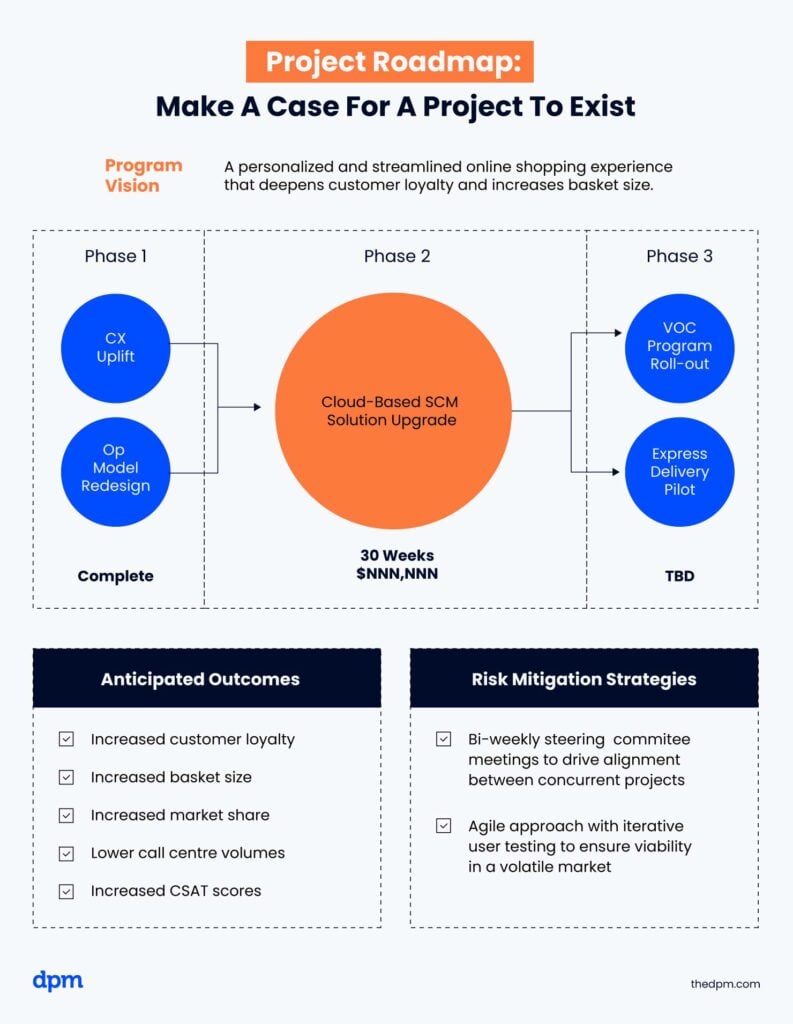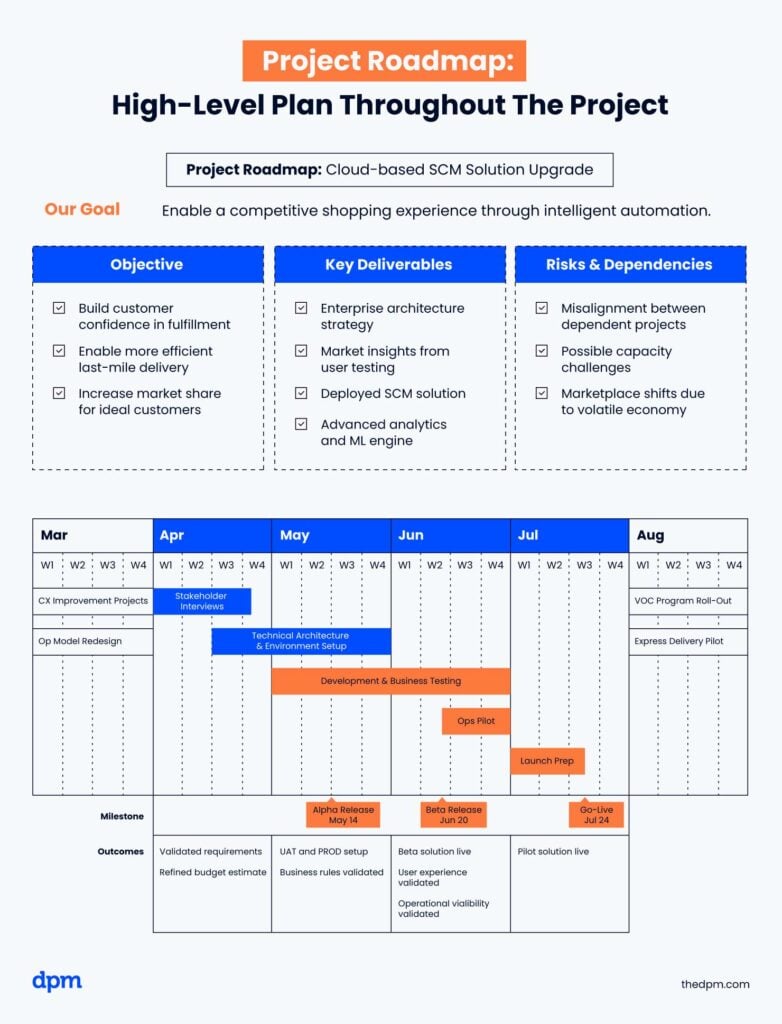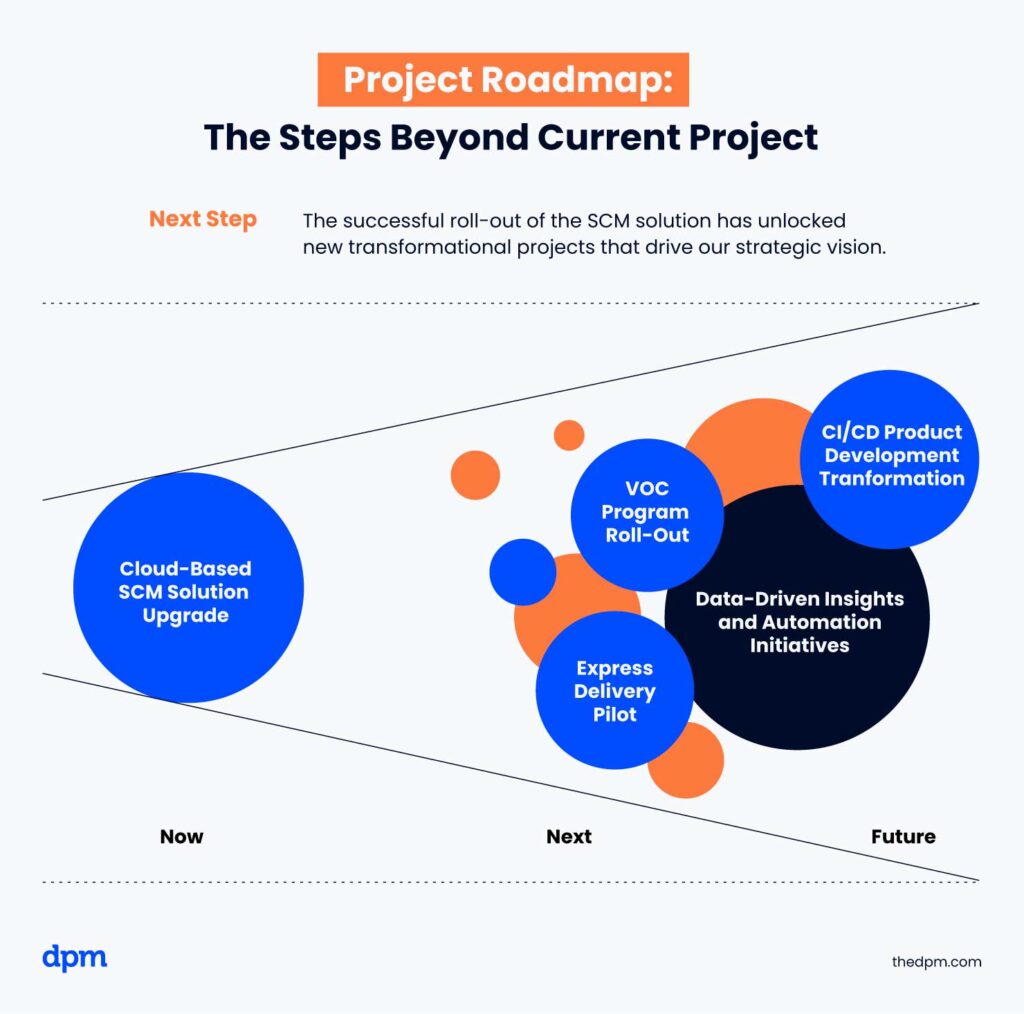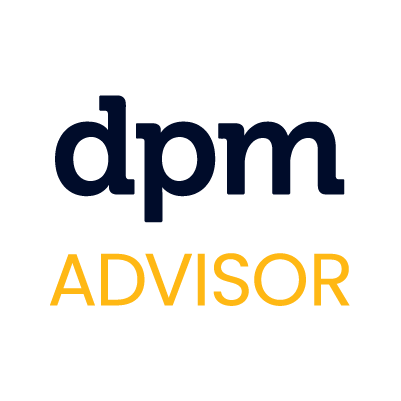When you need to present your project in a strategic context, one of the most useful documents you can create is a project roadmap. Unlike most other project artifacts, like a Gantt chart, a project roadmap shows not only what’s happening within your project, but also how your project fits within the big picture.
However, the exact purpose, definition, and process of creating a project roadmap can be somewhat contentious. That is why I have decided to compile my project roadmap expertise into this article.
After reading this article, you should be well equipped to:
- Present your project to your steering committee succinctly and spontaneously
- Convince a Dragon’s Den of executive sponsors that your project needs to exist
- Sell in the next phase of your program while you’re wrapping up your current project
In this article
- What Is A Project Roadmap?
- Project Roadmap + Examples
- Why Is A Roadmap Important?
- Project Roadmap In 5 Steps
- Project Roadmap Template
- Roadmapping In Your Process
- Recommended Roadmap Software
What Is A Project Roadmap?
In its most basic form, a project roadmap is an overview of the project, including the context, impetus, and logic of your project in strategic terms. Overall, it focuses more on the “why” more than the “how” or the “what”.
Many people involved in your project won’t need to absorb all the granular details of the project the way you do as the project manager. Therefore, a project roadmap focuses on the basics of the project that anyone can understand, including the project's context, its project objectives, and how it fits into the company's big-picture plans.
Why Is A Roadmap Important?
Okay, so we’ve talked about what’s in a project roadmap and what you might use it for, but why is it important to have a roadmap? Here are three simple answers:
- Not everyone has the time – a project roadmap allows you to convey the essence of your project in a snackable format for influential, but time-constrained audiences.
- Not everyone has the context – key stakeholders may dismiss or even oppose your project and put it at the bottom of their list of priorities unless they can be convinced that it is important.
- You don't want your project to be stagnant - if you don't frame your project in the context of the company's organizational objectives and strategic plan and vision, including the next steps after your project officially ends, your project cannot evolve and therefore cannot maximize its impact over time.

What does a project roadmap include?
At a bare minimum, a project roadmap should include the following:
- The project and program objectives
- A high-level project timeline or milestone view
- A summary of project deliverables or high-level goals
- Related risks & dependencies
However, it could also include a few other things to bolster the narrative, such as:
- The problem statement and/or hypothesis
- Justification for the project approach
- A listing of key individuals on the project team and a high-level resource management plan
- Next steps for after the project is completed to continue the vision for broader success
How To Make A Project Roadmap In 5 Steps
Alright, so how do you go about creating a project roadmap? Regardless of what stage of the project lifecycle you are in, your process should look something like this:
1. Assemble the context (The why)
Frame your project with the strategic context, focusing on the “why”. This could mean collecting the strategic objectives, the program vision, and the project objectives from assets like the project charter, the strategic plan, or the product roadmap. Equally, it could also mean conducting research with stakeholders and customers, performing a market assessment, or analyzing business data to validate the project approach (and that can be a project or phase of its own!).
2. Decide how to represent the high-level view (The how)
There are many ways to tell the story of how your project will achieve the objectives. Often this is a timeline summary that is simply a rolled-up Gantt, but it also might not be a chronological view: sometimes a flow chart, affinity diagram, or other visual representation will better represent the logic and dependencies of the project activities or their relationship to the project objectives.
3. Extract the key milestones & deliverables (The what)
Map the key deliverables to the project objectives, and summarize the outcomes they will drive. Based on that, downselect key milestones within your project timeframe so that they can be highlighted and discussed. Remember: without the “so what”, deliverables are just things and milestones are just dates.
4. Summarize the key risks and mitigation strategies
Take the highest impact risks and summarize the mitigation strategies. This could include project risks, but it could also include program risks, market risks, organizational risks. This is your opportunity to show what’s at stake and what precautions you are taking to ensure success.
5. Frame up the next and/or parallel steps
Contextualize your project within the bigger picture by explaining what should happen when the project completes (e.g., future phases, follow-on initiatives) as well as what related activities outside of your project are critica (e.g., your project + website uplift = CSAT problem solved).
What makes a project roadmap different?
Some might argue that a project roadmap is just another project management artefact that is made redundant by other project assets. I’d argue that it is not only unique in nature, but is also used much differently. Let’s do a few comparisons:
Project roadmap vs a Gantt chart or project plan
A Gantt is a detailed view of project activities and dependencies. A project roadmap may include only a high-level timeline view or milestone view, and that view might not even be chronological.
A Tip: If you are looking to make a project plan and Gantt chart.
Be sure to check out our Project Plan Guide.
Project roadmap vs Project charter
A project charter will indeed include a summary of the project objectives and the high-level details of budget, project timeline, and roles, but is typically a static representation of the project itself more than a living, contextual view of the project. A project roadmap is always being updated and focuses on the context and outcomes of the project.
Project roadmap vs Product roadmap
A product roadmap is typically meant to show the product development plan in terms of features, releases, and user impact. A project roadmap is more about causality and impact: the effect of doing these things will unlock doors along the way to our strategic objectives as an organization.
A Tip: If you are also involved in product management and are looking to create a product roadmap.
Be sure to check out this great article on Key Things to Include in a Product Roadmap.
Project roadmap vs a Strategic plan
A strategic plan and project roadmap both outline objectives to achieve a goal that will lead towards a broader vision. The main difference is that a strategic plan may be an even higher level view of organizational strategy that spins on multiple programs of projects. A project roadmap describes how the puzzle pieces fit, while a strategic roadmap is the full picture before we took a jigsaw to it.
How To Use A Project Roadmap + Examples
The contents of a project roadmap may differ depending on the intention of the roadmap and when you’re creating it. Based on the three stages described in the previous section, here are three example formats that illustrate a specific use case.
Example 1: The road leading up to the project
A project roadmap can be used to justify a project or present validated assumptions that build confidence that a project should proceed. In this case, the project roadmap could be the output of a discovery phase or even an entirely separate project.

Example scenarios:
- A service design project may begin with a research phase to validate hypotheses regarding the viability and accessibility of a digital service before building it. The project roadmap could be one of the outputs that would be used to rally support to greenlight the next steps of the project.
- Ambiguous requirements may warrant a separate project to create a detailed requirements document or prioritized product backlog of user stories. The project roadmap would describe how and why the requirements should be broken into phases and include a more accurate estimate for approval.
Pros:
- Can be monetized
- Reduces delivery risk by aligning stakeholder expectations and clarifying scope
- Can become the formal proposal
Cons:
- It’s a heavier document that may need some tailoring for other uses down the road
- Creating this document can be a project in and of itself
What’s in it?
- Background & Context
- Business hypothesis / hypotheses
- Research objectives
- Research methodology
- Research insights & outcomes
- Validated hypothesis / reframes problem statement
- High-level solution
– Project scope statement(s)
– High-level timelines
– High-level budget estimates
– High-level staffing estimates - Next steps
Example 2: The road we’re traveling
Throughout the project, a project roadmap can be used to raise awareness of a project and provide high-level status updates to peripheral stakeholders as well as new team members or subcontractors.

Example scenarios:
- You may be asked to present your project at a steering committee meeting, where project stakeholders are either being introduced to the project or are orchestrating other related programs. A project roadmap would provide a quick synopsis to drive the conversation.
- When onboarding a new team member to your project, a project roadmap can explain the context quickly so that they understand how their tasks contribute to the bigger picture.
Pros:
- Easy to digest for folks who are time constrained
- Often a distillation of project assets that already exist
- Can be used to explain high-level sprint goals within your agile project
Cons:
- Might become yet another artefact to maintain throughout your project
- Often misunderstood as the actual project plan
What’s in it?
- Background & Context
- Actionable research insights
- Program objectives
- Program components & logic/rationale
- Project scope & Project timeline (high-level overview)
- Risks & Mitigation strategies (high-level overview)
Example 3: The road beyond
As a project reaches its successful conclusion, a project roadmap can be used to reiterate the next steps and encourage project sponsors to use the current momentum to continue towards broader strategic objectives.

Example scenarios:
- You may be invited to present the project successes to a senior leadership team or executive team so that they can promote the roll-out.
- You may be asked to help plan future project phases and adjustments to other related projects based on the outcomes of your current project.
Pros:
- Great for keeping momentum going into the next phase
- Leverages the success of your current project
Cons
- Often needs to be tailored and presented when your project is at its most all-consuming moments
- Can be interpreted as “sales” by stakeholders and team members alike
What’s in it?
- Background & Context
- Program objectives / North Star vision
- Project outcomes & Implications
- Program timeline (high-level overview)
- Risks & Mitigation strategies (high-level overview)
- Next phases
How To Use Roadmapping In Your Process
While it is a good idea to keep your roadmap up to date throughout your project, the good news is that it doesn’t necessarily need to be a daily activity. Here’s how to work it into your process.
Prior to Project Start
A roadmap is a great way to start articulating a case for your project. Start by documenting your ideas into a roadmap format to save yourself time once your project is approved.
At this stage, it may be more of a hypothesis that is part of a broader business case that you and the team are using to drive alignment and build consensus. It definitely won’t be complete, so get comfortable with the idea that this is a living document.
When Initiating the Project
A project roadmap makes a great starting point for a project kick-off deck and vice versa. After kick-off, transform your kick-off deck into a roadmap format while it’s still fresh, and keep it up to your sleeve.
When Planning the Project
There’s a lot of activities you could do in your project, but are they all going to drive the desired outcomes? When starting to plan the project in detail, use your project roadmap to keep your perspective grounded in the business objectives.
Once your detailed plan is complete, add or update the relevant details in your project roadmap so that you don’t need to frantically make edits the next time you need to present your roadmap.
When Executing the Project
While the project is in its execution phase, use your project roadmap to brief new team members as well as new stakeholders. This turns a verbal conversation about the nitty-gritty details into a more strategic understanding of where the project sits in the broader vision. It can even boost confidence, engagement, and morale!
When Monitoring & Controlling the Project
If you have a high-level timeline view, update it regularly and use it as the centerpiece for your stand-ups and status meetings so that your team continues to see the forest for the trees. Keep versions of your roadmap if any details change so that you can revisit it as the baseline.
When Closing Out the Project
Incorporate the outcomes of your successful project and how the results will enable next steps in the program or initiative it sits within. Use it to present outcomes to your client team or sponsor as well as your team (e.g., as part of your project retrospective).
Project Roadmap Template & Tools
To help you get started, we’ve included a template roadmap for a simple single-page roadmap. Use it during the project planning process or throughout the project lifecycle, but remember to tailor it to reflect your project’s goals.
You can copy or download the project roadmap template here!
For more complex examples and discussions about specific strategies for using project roadmaps, consider becoming a member of The Digital Project Manager community.
If you’re looking to create something a bit different, feel free to also investigate the best roadmap software on the market to find what will work for you.
Need expert help selecting the right Project Management Software?
If you’re struggling to choose the right software, let us help you. Just share your needs in the form below and you’ll get free access to our dedicated software advisors who match and connect you with the best vendors for your needs.
What Do You Think?
So that’s project roadmaps in a nutshell! They can be used in many different ways using various different project management tools, but the key is to have a high-level summary that captures the essence of your project for a broad audience. It’s useful when you need to summarize the details and present the forest for the trees on a whim, whether that’s before the project starts, when the project is underway, or as the project is reaching its end.
Do you have any tips for maintaining a project roadmap throughout a project lifecycle? Do you have a novel way to create or use a project roadmap? Let me know in the comments!
Want to take this conversation to the next level and discuss the soft skills and strategies for presenting a roadmap with impact? Become a member of our community and join the conversation with thousands of global practitioners!
List of Related Tools: Project Roadmap Software



